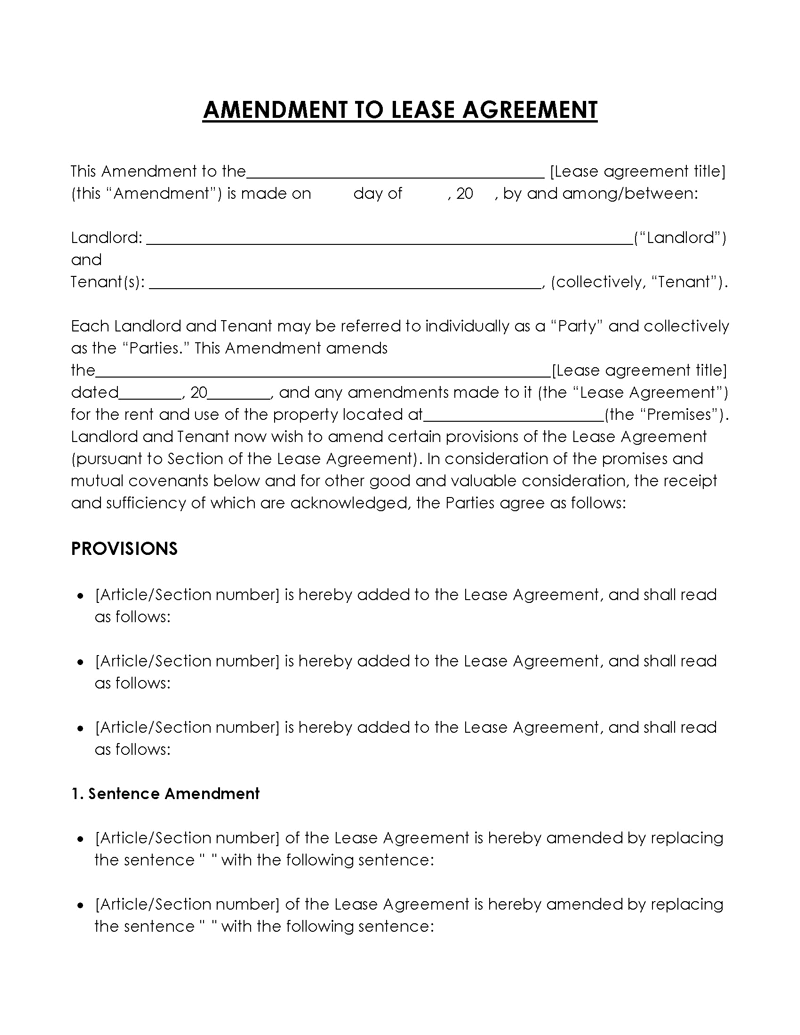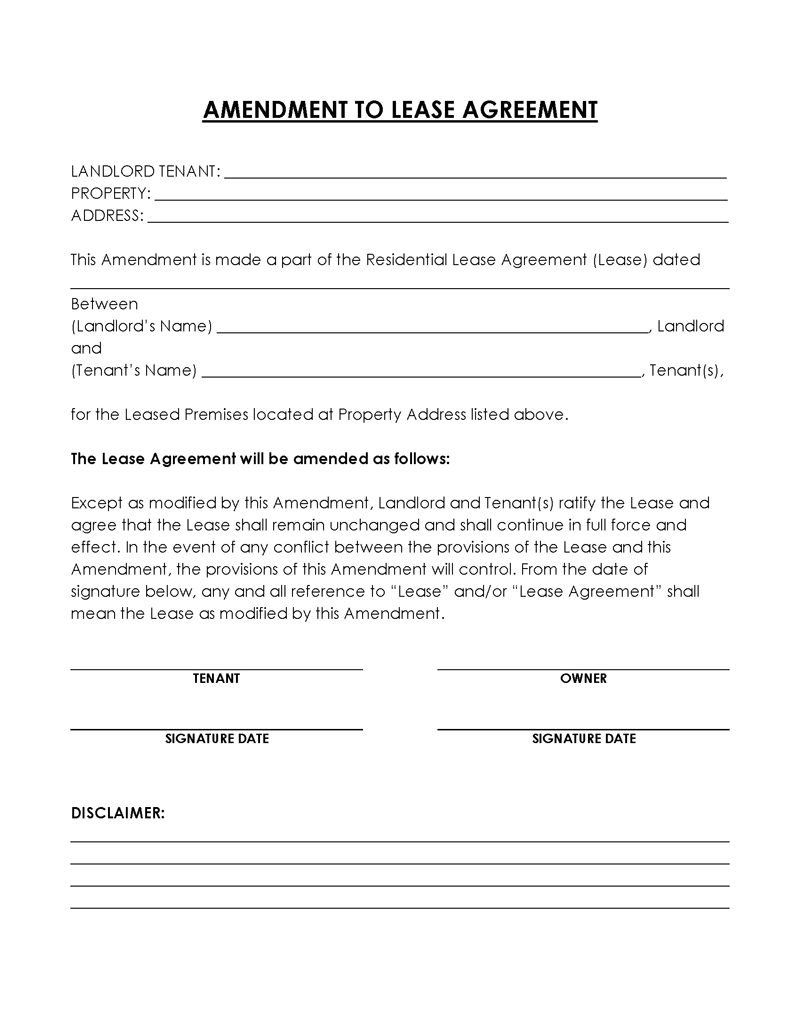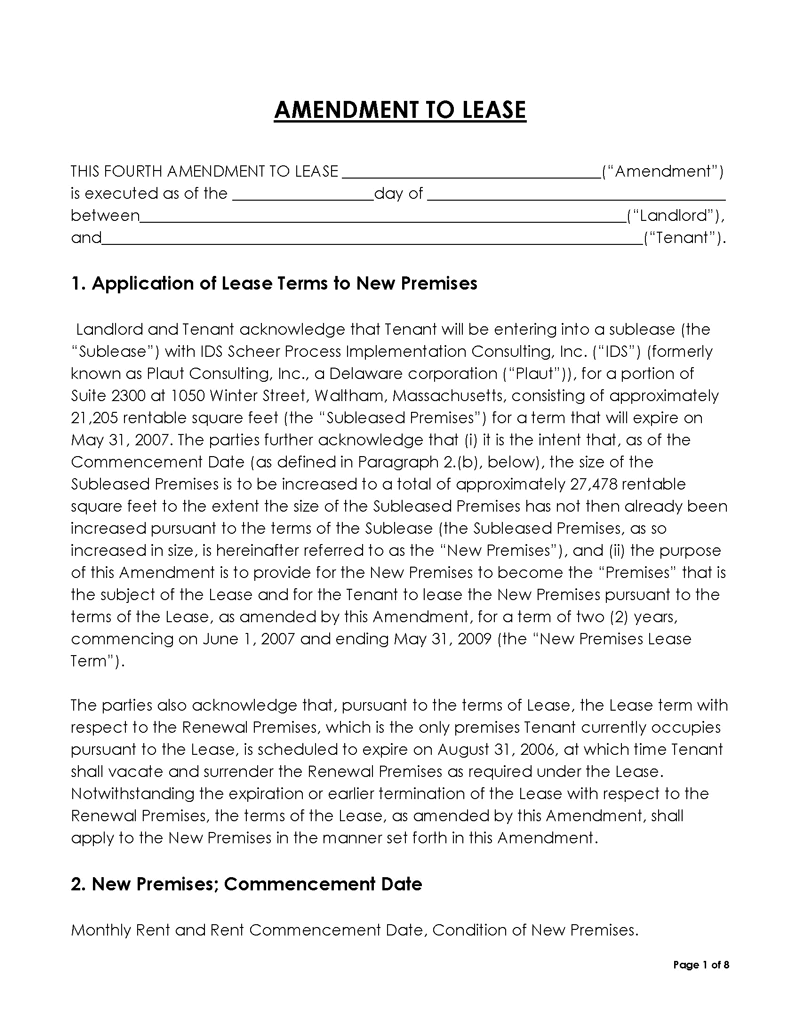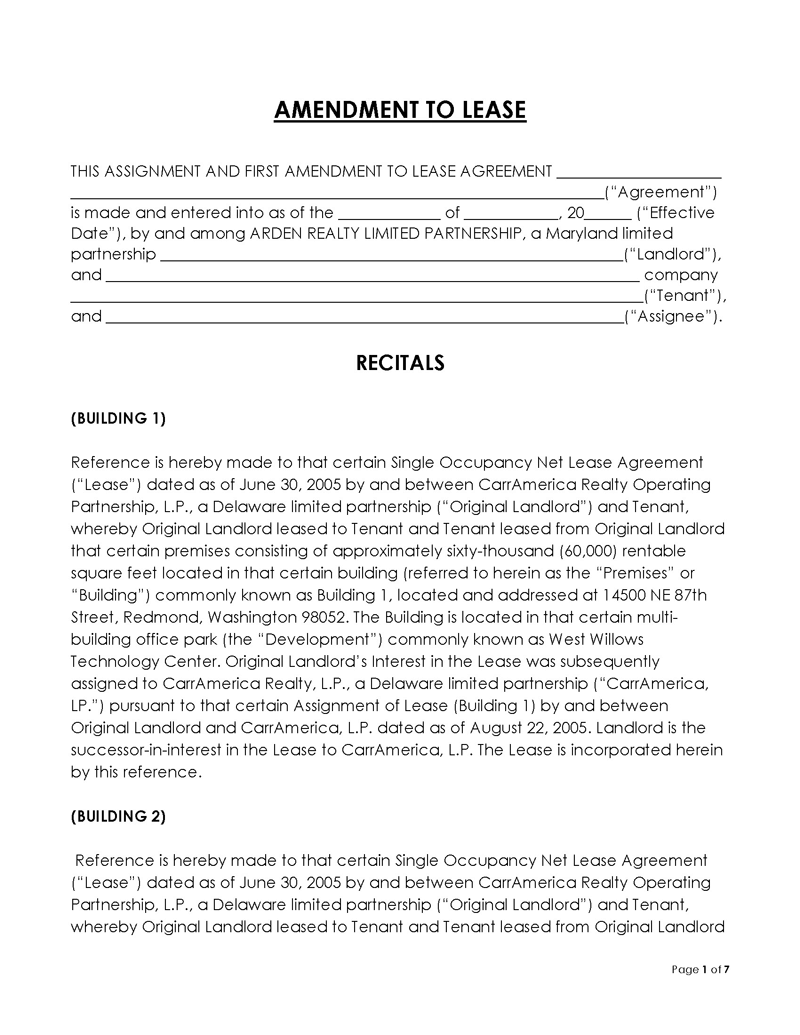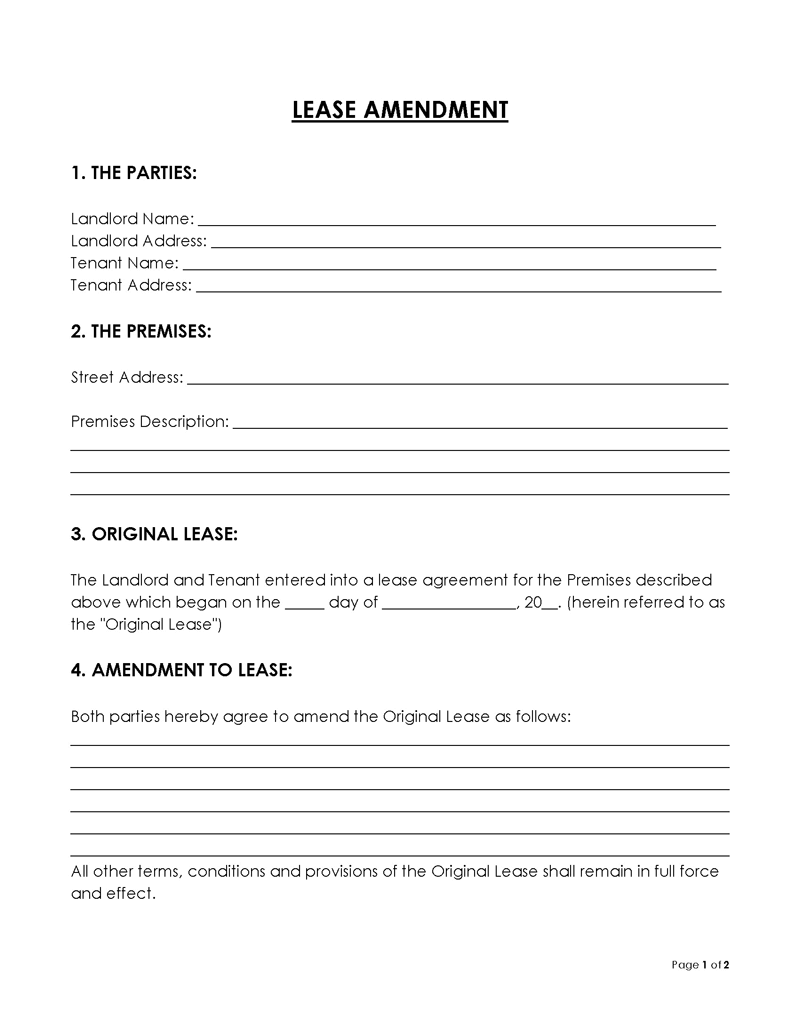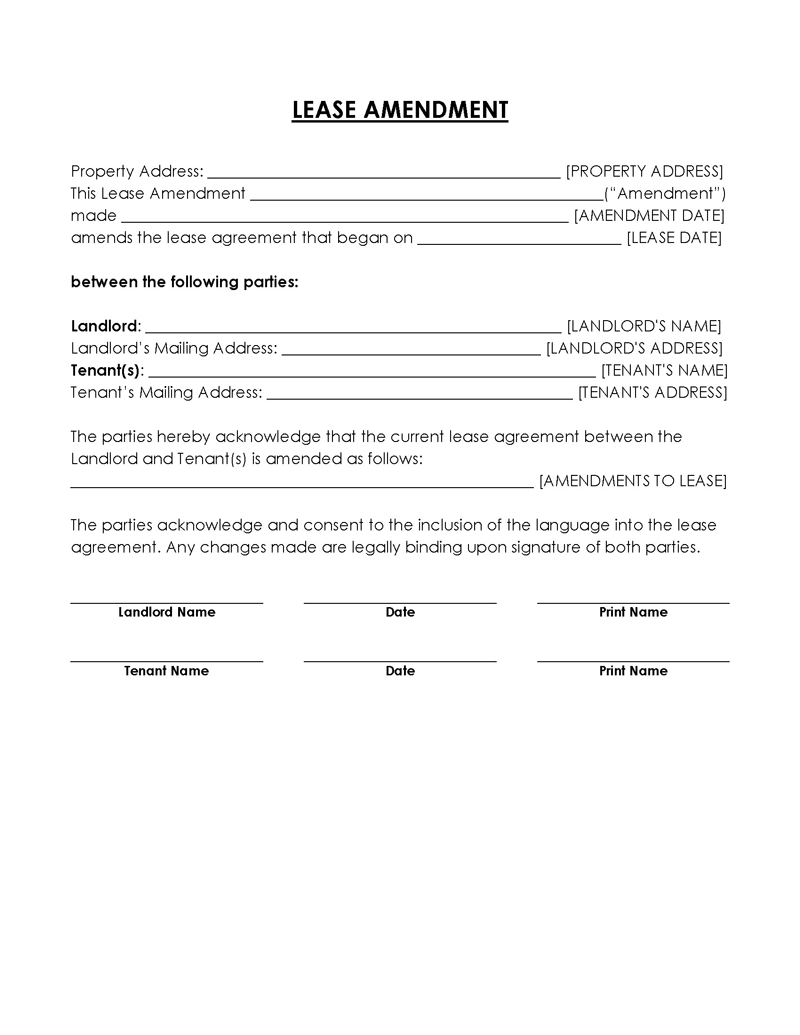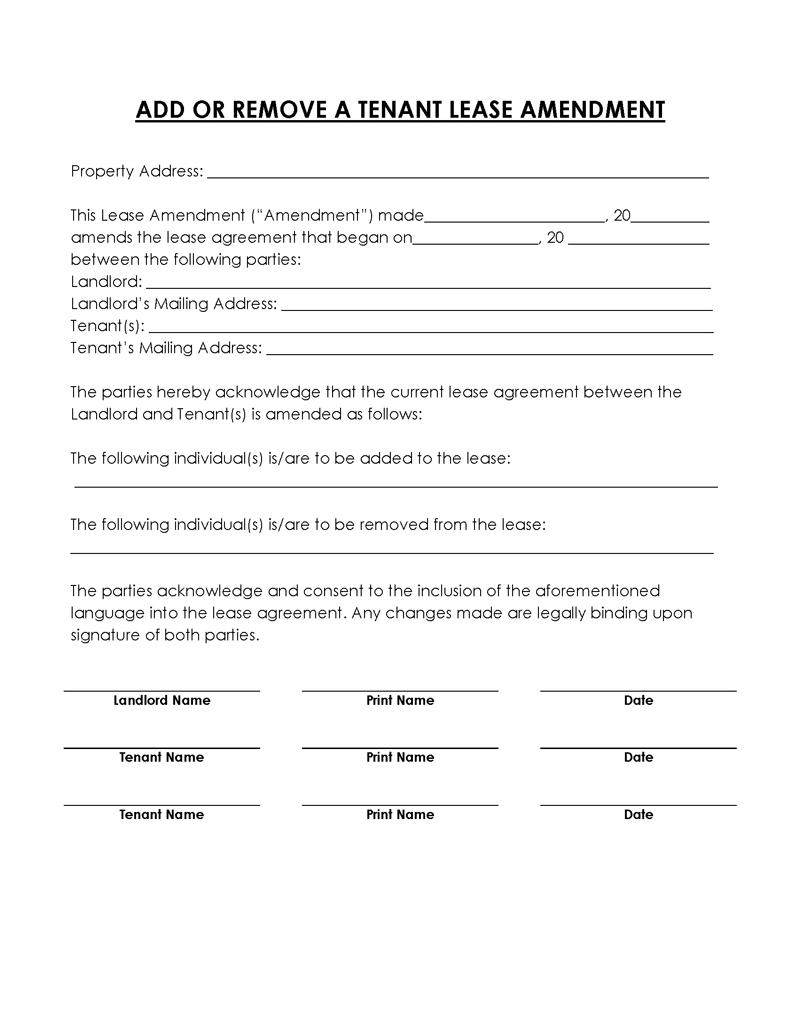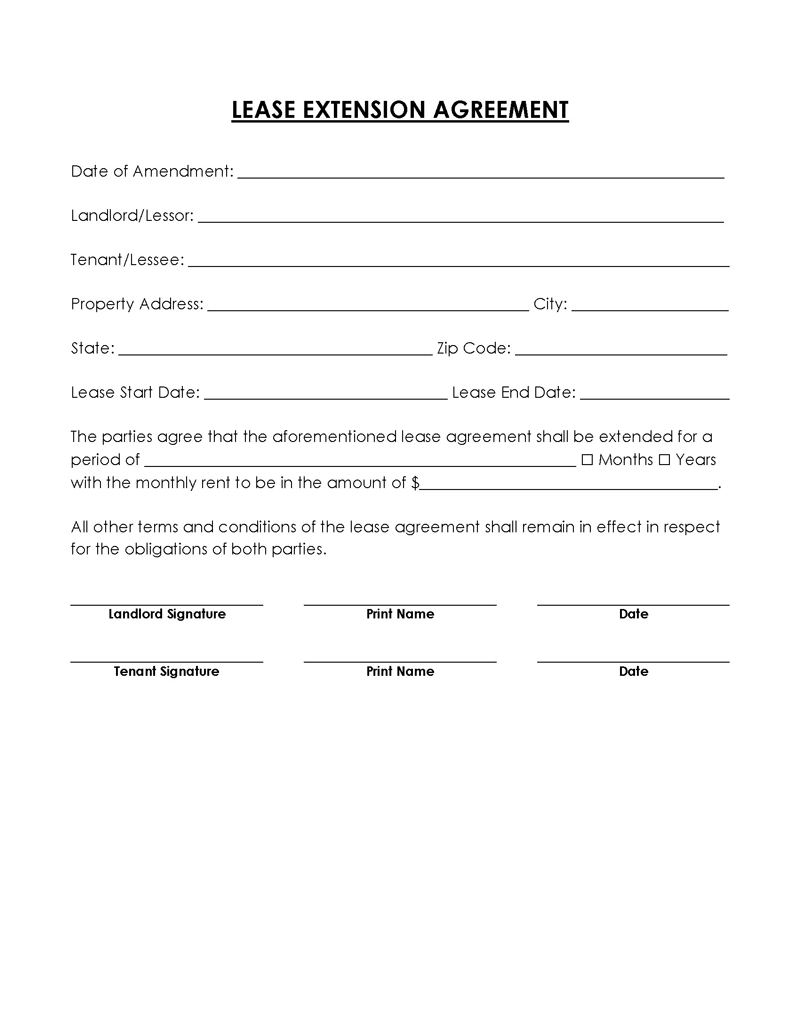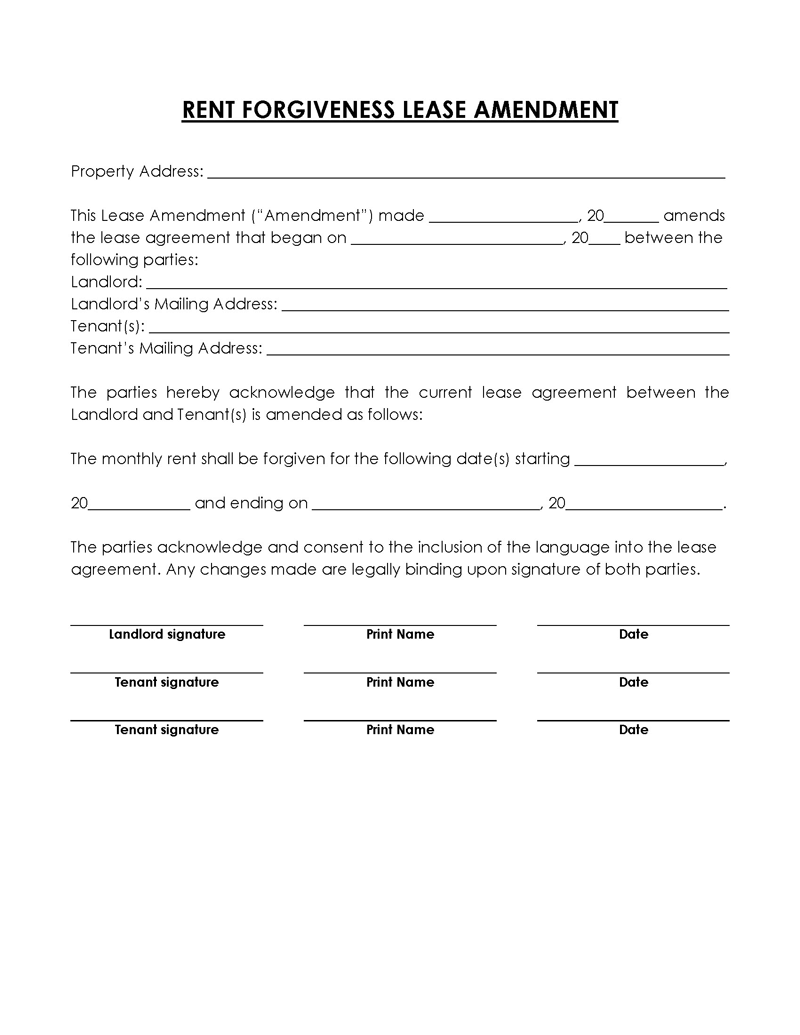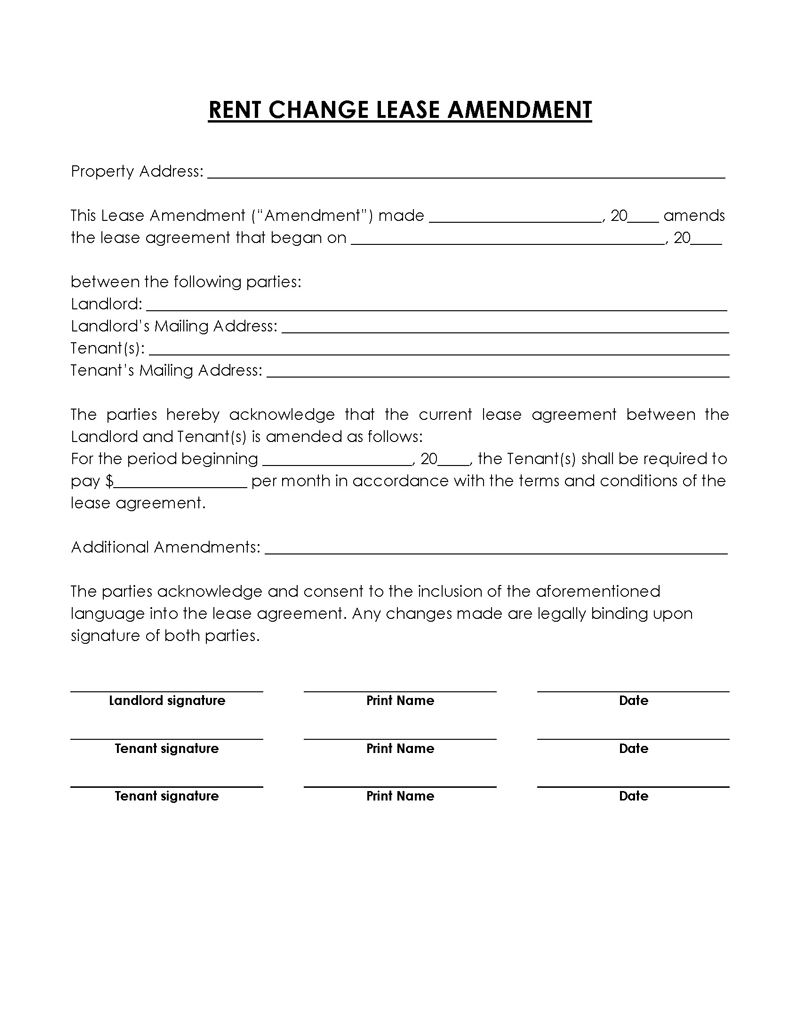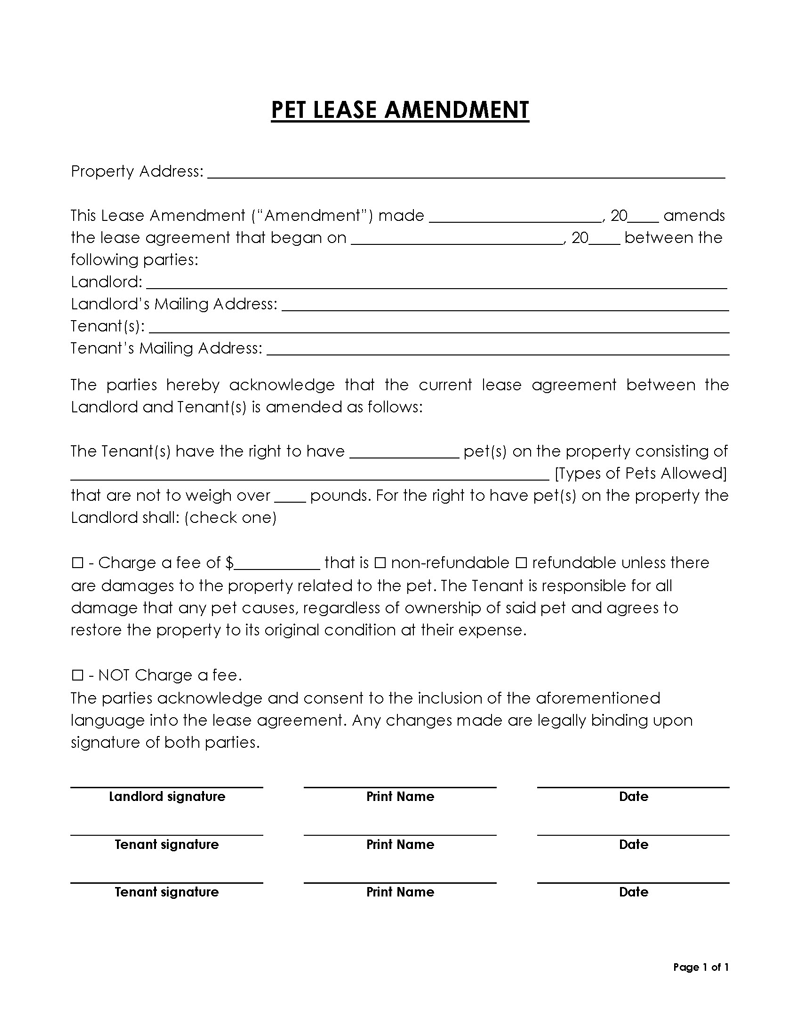The current housing market is experiencing many changes, and due to expensive living costs, many people have had to move to cheaper places or change the terms of their lease agreements.
Once the property owner and tenant sign a lease agreement, it becomes legally binding; any change in the lease agreement’s terms must be communicated to the other party before it is enforced. These changes are often expressed through a lease amendment form. A lease amendment form records the changes made to the original lease agreement by stating the additional terms or the terms of the lease agreement that have been changed. The amendment is an addition to the original lease, meaning the original lease remains unchanged for the initially stated terms in the amendment.
This article discusses a lease amendment and when it can be used. It also discusses the process of creating an amendment form and how to complete it. The article also discusses the changes that can be made to a lease through an amendment form and provides free downloadable templates you can use to create your lease amendment.
Download Free Templates
Given below are lease amendment form templates:
Lease Amendment
A lease amendment is a document used to modify the terms of an existing lease agreement by indicating clauses that have been added, removed, or changed.
The changes can be made to both commercial and residential lease agreements. The amendment shows that particular terms of the original lease have been changed, allowing the property owner and tenant to agree on new terms without having to sign a new lease.
Before the lease amendment is prepared, the changes must be discussed between the tenant and property owner, consented to, and signed. This is because the original lease is a binding agreement. Once the amendment is signed, it should be attached to the original lease, and a copy should be provided to the parties involved.
Alternate Names
The lease amendment may be called by different names in different jurisdictions, and sometimes, the amendment is named according to its purpose. This difference in names occurs because of the applicable laws or standard practices of where the lease is signed.
Some alternate names include:
- Amendment to lease
- Lease amending agreement
- Lease addendum
- Alteration of the lease agreement
- Amendment to commercial lease
- Amendment to residential lease
- Lease modification agreement
- Lease renewal agreement
- Lease extension
When and Who can Amend a Lease?
A lease amendment records significant changes made to the terms of the original lease agreement; as such, it is crucial to know who can make changes and when they can be made. Some significant changes that can be made to a lease include adjustment of the lease’s length or pertinent terms that affect the property, like maintenance and improvement.
When
A lease amendment is used in particular circumstances. For example, minor changes that do not affect the terms of a lease do not require a lease amendment if they can be made by the property owner unilaterally.
Some of the circumstances in which a lease amendment would be necessary include:
- Where the property owner or tenant decides to change the lease length, renew the lease, or modify the terms for termination of the lease.
- The property owner wants to change the permission policy in the original lease, for example, changing the lease to allow the tenants to have pets.
- Changes to the number of occupants allowed per unit for shared houses.
- A raise or reduction in the rent to be paid.
- Alterations to the usage and maintenance of the property, for example, maintaining lawns or backyards.
- Modifications that affect the property’s value include storage units, parking spaces, or sheds.
- Adjustment of rental terms, for example, to include or prohibit subletting.
- Swapping tenants from one unit to another on the same property.
- Adding terms requiring the tenant to get renter’s insurance.
- Changing or replacing a guarantor.
- The property owner allows the tenant to construct and make improvements on the property.
- Addition or deletion of particular restrictions on the property.
Who
The tenant or property owner can write a lease amendment. The preparer of the form needs to discuss the modifications with the other party. However, some decisions can be made unilaterally as long as stated in the original lease. Because the lease is a binding agreement, both parties must discuss any changes before drafting the amendment.
Amending a Lease
When amending a lease, it is advisable to use a form stating which lease term needs to be changed and how the new terms will be applied. For instance, the amendment may include checklists, payment tables, or photographs concerning the new provisions.
When the property owner or tenant needs to amend a lease, they must get the other party’s consent. Then, they both have to discuss, write and sign the form. Because the lease is a formal document that may be used in legal proceedings, it must comply with state laws and local regulations.
Both residential and commercial leases can be amended to suit the parties’ needs, provided that the changes are not discriminatory to either party or illegal.
Discuss with the other party
The party proposing an amendment needs to communicate why they want to make the change for the other party to give consent. Therefore, it is essential to highlight the change, so it is not vague. For example, if the property owner wants to add a new unit that will affect the tenant’s usage of the property, they may offer to reduce the rent or maintenance charges on the property. It allows the parties to negotiate and reach an agreement.
Write the amendment
Once the intended changes have been communicated, the amendments should be written. For ease of reference, the amendment should state when the original lease was signed and which term is to be amended. Again, it is best to communicate these changes via email so there is a communication record.
Sign the form
Once the changes have been made, the property owner and tenant can meet and sign the amendment. The amendment can also be signed electronically. It should then be attached to the original lease.
Tip: Before making changes to the lease agreement, parties to the lease should consult state laws and regulations to see whether the change is legal. Some state laws also prescribe how particular changes may be implemented and how many changes can be made. It is assumed that property owners have more information on preparing lease agreements and more experience dealing with rogue tenants; as such, it is easier for them to prepare amendments.
How to Write
The lease amendment is usually drafted as a form stating the details of the parties, the property, and the amendments to be made. However, property owners often prepare it, so it is essential to know which information to include and how to write it:
Property address
Since the modifications affect the original lease, it is crucial to identify the property rented. For ease of reference, the geographical and physical address used in the official lease should be recorded in the property address section.
Lease amendment date
The lease amendment is attached to the original lease, and the new terms will take effect on the date indicated in the amendment. It is necessary to state the date the amendments take effect to ensure both parties understand when their obligations begin as indicated in the agreement.
Identify the parties
Some lease amendments involve varying the lease terms to add or remove a tenant; as such, it is good to indicate the property owner and tenant details for identification.
Property owner’s name and mailing address
Identify the property owner by indicating their legal name and mailing address in the required section. Use the entity’s legal name if the property is owned by a company or property management entity.
Tenant’s name and mailing address
Like the property owner, the tenant must be identified by their legal name and mailing address. It is essential to indicate the tenant’s name because some amendments require adjusting the lease to include a new tenant.
New conditions or terms
Indicate the new conditions or terms concerning the original lease. Begin by stating the terms of the original lease as they are written, including the sections under which they fall, and then note the new terms as they apply.
Document sentence amendments
If the amendment involved varying a sentence in the original lease, indicate the sentence as it was and state the amended sentence.
Note sentence deletions
Where an entire sentence will be deleted, indicate the sentence as it was in the original lease and state that it is deleted in the amendment.
Identify section amendments and restatements
Where a section has been amended, state the section that has been amended and write the new section as per the amendment. Where the section remains the same, restate that the particular section remains unchanged.
Note a specific sectional change
Where part of a section has been changed, indicate the part amended and state the amendment.
Additional provisions
Where new provisions have been added, indicate the conditions and state that they are additional to the original lease provisions.
Governing laws
Remember that some states have laws and regulations for lease agreements; as such, it is essential to check the laws the amendment should comply with and indicate them.
Property owner and tenant’s signatures
Signing the agreement indicates the parties consent to the new terms. Before signing, the parties should read the amendment again to see whether they agree to the new terms; if they do, they should sign in the appropriate spaces.
Date
The agreement’s date on which it is written has to be indicated as it may differ from the date the amendment will take effect. It may also be used as a reference when the new terms come into force; for example, ‘this amendment takes effect 30 days from the date of signing’.
Fact check: The lease and the amendment become valid when the property owner and the tenant sign them. Therefore, any changes made without the consent and signature of the tenant are invalid and cannot be enforced.
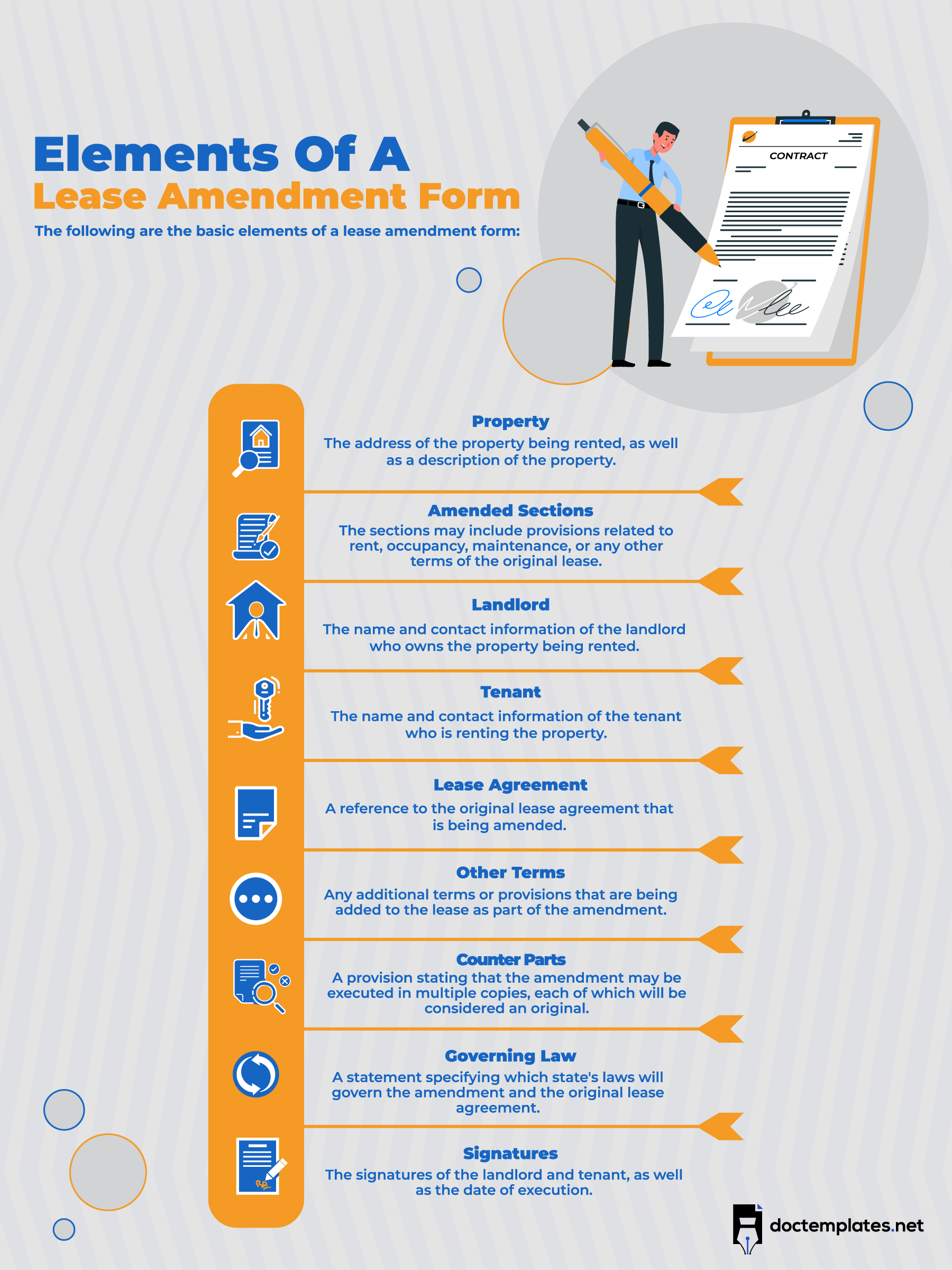
Lease Amendment Form
The lease amendment form can be complex and time-consuming to create. To make it easy for you, we provide different types of free downloadable lease amendment forms you can use. The templates can be edited to satisfy the parties’ needs and used repeatedly.
There are different types of lease amendment forms depending on the purpose of the amendment, including:
Add/remove a tenant
An amendment to add or remove a tenant from the lease is used when the lease involves more than one tenant. For example, when the landlord has to add another tenant or new tenant shifts into the property, an amendment may be used to record the change in tenancy and state the new tenant’s tenancy terms.
The extension (Extend lease)
An amendment to extend a lease is used where the parties intend to extend the lease beyond the date stated in the original agreement. The agreement may also vary the rent to be paid once the amendment for extension takes effect.
Forgiveness of rent
When a tenant loses their source of income or cannot pay rent, the property owner and tenant may sign an agreement allowing the tenant to stay without paying rent for a particular period. The amendment has to state explicitly how long the rent forgiveness period is. It should also note the date the tenant is supposed to pay rent on.
Increase/decrease monthly rent
Due to the expensive cost of living, it may be necessary to increase or decrease rent; this is where an amendment to increase or decrease the rent is used. In addition, the amendment should indicate when the change in rent will take effect.
Pet amendment
Some property owners do not allow pets; an agreement enabling tenants to keep pets should be made when it becomes necessary. The contract should state the types of pets allowed on the property and the terms of this permission.
Consequences of Not Using a Lease Amendment Form
Changes to a lease often affect the property owner and tenant, so it is crucial to have them in writing in case legal issues arise. Some of the consequences of not using a lease amendment form include the following:
Lost money
If the property owner or tenant fails to use an amendment form, it may cause the other party financial loss. For example, property owners may incur the cost of removing unwanted improvements made by tenants after they leave, receiving less rent than expected, and the costs of calling an exterminator to deal with fleas left by a tenant’s pet. On the other hand, tenants might have to contend with a sudden rent increase, pay penalties for having a pet on the property or be unable to make improvements to the property.
Mental anguish
If a change was agreed upon verbally, the tenant or property owner might not have a record of the agreement. As a result, the agreeing party may refuse to implement the change, which could cause a strain on the landlord-tenant relationship. This lack of trust may cause unnecessary mental anguish and lead to difficult living situations. The property owner may fail to trust their tenant concerning the maintenance of the property, or the tenant can act according to the verbal agreement. The tenant may also not trust the property owner and live with the constant anxiety that they may be evicted anytime.
Lost time
Poor communication leads to arguments over issues that could have been easily solved if they had been written. As a result, the property owner may subject themselves to lengthy court proceedings to enforce their rights over the property or even waste time preparing a new lease and inspecting the property. The tenant may also have to schedule a time to be at the property for inspections.
Frequently Asked Questions
How many amendments can you make using the lease amendment form?
Typically, you can make up to five amendments using a lease amendment form. However, it is better to negotiate a new lease with new terms where you need to make many changes.
After amending a lease agreement, do the original lease terms still apply?
Yes, the original lease terms still apply after the amendment. The only terms that change are those that are written in the amendment. The amendment is considered an addition to the terms of the lease.
